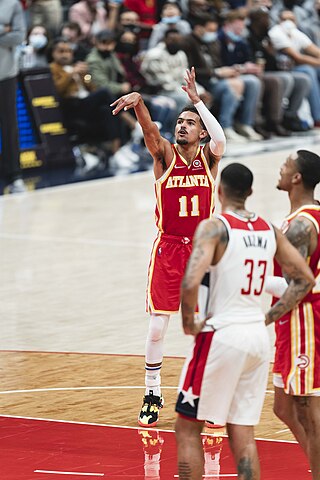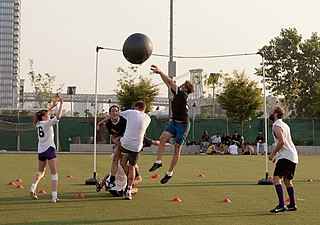Related Research Articles

Basketball is a team sport in which two teams, most commonly of five players each, opposing one another on a rectangular court, compete with the primary objective of shooting a basketball through the defender's hoop, while preventing the opposing team from shooting through their own hoop. A field goal is worth two points, unless made from behind the three-point line, when it is worth three. After a foul, timed play stops and the player fouled or designated to shoot a technical foul is given one, two or three one-point free throws. The team with the most points at the end of the game wins, but if regulation play expires with the score tied, an additional period of play (overtime) is mandated.
In basketball, a technical foul is any infraction of the rules penalized as a foul which does not involve physical contact during the course of play between opposing players on the court, or is a foul by a non-player. The most common technical foul is for unsportsmanlike conduct. Technical fouls can be assessed against players, bench personnel, the entire team, or even the crowd. These fouls, and their penalties, are more serious than a personal foul, but not necessarily as serious as a flagrant foul.

A shot clock is a countdown timer used in a variety of games and sports, indicating a set amount of time that a team may possess the object of play before attempting to score a goal. Shot clocks are used in several sports including basketball, water polo, canoe polo, lacrosse, poker, ringette, korfball, tennis, ten-pin bowling, and various cue sports. It is analogous with the play clock used in American and Canadian football, and the pitch clock used in baseball. This article deals chiefly with the shot clock used in basketball.

In basketball, free throws or foul shots are unopposed attempts to score points by shooting from behind the free-throw line, a line situated at the end of the restricted area. Free throws are generally awarded after a foul on the shooter by the opposing team, analogous to penalty shots in other team sports. Free throws are also awarded in other situations, including technical fouls, and when the fouling team has entered the bonus/penalty situation. Also, depending on the situation, a player may be awarded between one and three free throws. Each successful free throw is worth one point.

In basketball, a personal foul is a breach of the rules that concerns illegal personal contact with an opponent. It is the most common type of foul in basketball. A player fouls out on reaching a limit on personal fouls for the game and is disqualified from participation in the remainder of the game.

A jump ball is a method used to begin or resume play in basketball. It is similar to a face-off in ice hockey and field lacrosse and a ball-up in Australian rules football. Two opposing players attempt to gain control of the ball after an official tosses it into the air between them.

The rules of basketball are the rules and regulations that govern the play, officiating, equipment and procedures of basketball. While many of the basic rules are uniform throughout the world, variations do exist. Most leagues or governing bodies in North America, the most important of which are the National Basketball Association and NCAA, formulate their own rules. In addition, the Technical Commission of the International Basketball Federation (FIBA) determines rules for international play; most leagues outside North America use the complete FIBA ruleset.

Goaltending is a violation of the rules in the sport of basketball. It consists of certain forms of player interference with the ball while it is on its way to the basket. It is goaltending if a player touches the ball when it is (a) in downward flight; or (b) above the basket rim and within an imaginary cylinder projecting above the rim; or (c) already touching the rim; or after it has touched the backboard and has a chance of going in the hoop.
In the game of basketball, carrying is a ball-handling violation. Like other violations, the penalty is that possession of the ball is given to the opposing team. Statistically, this counts as a turnover of the ball.
In basketball, traveling is a violation of the rules of basketball in which a player takes more than a predefined number of steps while holding the ball. Taking more steps without dribbling than this limit will result in a turnover and possession of the ball for the other team.

In basketball, a flagrant foul is a personal foul that involves excessive or violent contact that could injure the fouled player. A flagrant foul may be unintentional or purposeful; the latter type is also called an "intentional foul" in the National Basketball Association (NBA). However, not all intentional fouls are flagrant fouls, as it is an accepted strategy to intentionally commit a foul in order to regain possession of the ball while minimizing how much time elapses on the game clock.

This glossary of basketball terms is a list of definitions of terms used in the game of basketball. Like any other major sport, basketball features its own extensive vocabulary of unique words and phrases used by players, coaches, sports journalists, commentators, and fans.
Variations of basketball are games or activities based on, or similar in origin to, the game of basketball, in which the player utilizes common basketball skills. Some are essentially identical to basketball, with only minor rules changes, while others are more distant and arguably not simple variations but distinct games. Other variations include children's games, contests or activities intended to help the player practice or reinforce skills, which may or may not have a competitive aspect. Most of the variations are played in informal settings, without the presence of referees or other officials and sometimes without strict adherence to official game rules.
In basketball, the five-second rule, or five-second violation, is a rule that helps promote continuous play. There are multiple situations where a five-second violation may occur.

The key, officially referred to as the free throw lane by the National Basketball Association (NBA), the National Collegiate Athletic Association (NCAA), the National Association of Intercollegiate Athletics (NAIA), and the National Federation of State High School Associations (NFHS), and the restricted area by the International Basketball Federation (FIBA), also simply called the lane, is a marked area on a basketball court surrounding the basket, where much of the game's action takes place.

In basketball, an official enforces the rules and maintains order in the game. The title of official also applies to the scorers and timekeepers, and other personnel that have an active task in maintaining the game. Basketball is regarded as among the most difficult sports to officiate due to the speed of play, complexity of rules, the case-specific interpretations of rules, and the instantaneous decision required.
In basketball, basket interference is the violation of (a) touching the ball or any part of the basket while the ball is on the rim of the basket, (b) touching the ball when it is entirely within the cylinder extending upwards from the rim, (c) reaching up through the basket from below and touching the ball, whether it is inside or outside the cylinder, or (d) pulling down on the rim of the basket so that it contacts the ball before returning to its original position, or during a shot attempt. How the ball gets into the cylinder or onto the basket is irrelevant under high school and NCAA rules; e.g., a pass touched within the cylinder is basket interference, even though such a play may not score a goal. This similar play under (W)NBA rules would not be basket interference.
Basketball is a ball game and team sport in which two teams of five players try to score points by throwing or "shooting" a ball through the top of a basketball hoop while following a set of rules. Since being developed by James Naismith as a non-contact game that almost anyone can play, basketball has undergone many different rule variations, eventually evolving into the NBA-style game known today. Basketball is one of the most popular and widely viewed sports in the world.

Circle rules football, commonly referred to as circle rules, is a team sport played between two teams of six with a large spherical ball similar to a stability ball. Invented in New York City in 2006, the sport is currently played in cities across the United States, as well as in several international locations.

3x3 basketball is a variation of basketball played three-a-side, with one backboard and in a half-court setup. This basketball game format is currently being promoted and structured by FIBA, the sport's governing body. Its primary competition is an annual FIBA 3X3 World Tour, comprising a series of Masters and one Final tournament, and awarding six-figure prize money in US dollars. The FIBA 3x3 World Cups for men and women are the highest tournaments for national 3x3 teams. The 3x3 format has been adopted for both the 2020 Summer Olympics and 2022 Commonwealth Games.
References
- ↑ Basketball rules fundamentals - NFHS rulebook 17-18
- ↑ NBA Official Rules (2009-2010) Archived 2012-01-11 at the Wayback Machine Rule 4, Section II, A. Retrieved July 26, 2010
- ↑ NBA Official Rules (2009-2010) Archived 2012-01-11 at the Wayback Machine Rule 4, Section II, a. Retrieved July 26, 2010
- ↑ FIBA Official Basketball Rules 2017. Retrieved February 22, 2018
- ↑ 2009-2011 Men's & Women's Basketball Rules Archived 2012-08-06 at the Wayback Machine Rule 9, Section 15, Article 1. Retrieved July 26, 2010
- ↑ NBA Official Rules (2009-2010) Archived 2012-01-11 at the Wayback Machine Rule 10, Section II, e, Penalties
